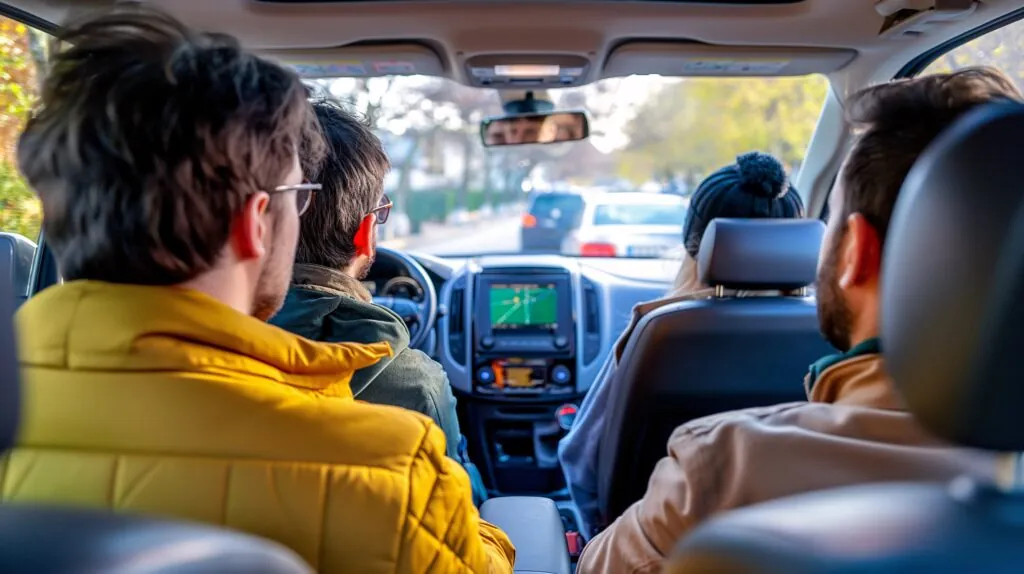There Was an Accident During My Rideshare—What Do I Do Next?
Steps to Take After a Rideshare Accident
Rideshare services like Uber and Lyft have revolutionized the way we travel, offering convenience, affordability, and flexibility. Yet, with the increasing number of rideshare vehicles on the road, accidents have become more common. If you find yourself involved in a rideshare accident, knowing what steps to take is crucial.
Whether you’re a passenger, another driver, or a pedestrian involved in a rideshare incident, the aftermath can be confusing and overwhelming. Who is responsible? How do you file an insurance claim? Do you need a lawyer? This comprehensive guide covers all aspects, from immediate safety measures to understanding insurance policies, filing claims, and knowing your legal rights.
Immediate Steps to Take After a Rideshare Accident
The first few moments after an accident are critical. Your actions can impact your safety, legal rights, and insurance claims. Here are the essential steps to take right after a rideshare accident.
Ensure Safety and Call Emergency Services
Your safety and the safety of others is the top priority. In the chaos of an accident, it’s easy to panic, but staying calm and composed is essential. Here’s what to do:
- Check for Injuries and Call for Help
Check yourself and others for injuries. Even if injuries seem minor, they could worsen later. Call 911 for medical help if needed. - Move to a Safe Location
If possible, move to the side of the road or a safe area to avoid further collisions. Turn on hazard lights to alert other drivers. - Wait for Emergency Services and Cooperate with Authorities
Remain at the scene until the police and medical personnel arrive. Cooperate with the authorities and provide accurate information. The police report is crucial for insurance claims and legal proceedings. - Why Calling Emergency Services is Important
Calling emergency services ensures medical attention for all parties involved. It documents the accident officially, which is necessary for insurance claims. It also helps determine liability, which can be complex in rideshare accidents.
Gather Information and Evidence
Collecting information and evidence at the scene is vital for building a strong insurance claim or legal case. Here’s what you should do:
- Exchange Contact Information and Details
Exchange names, phone numbers, and insurance details of all parties involved, including the rideshare driver, other drivers, and witnesses. - Record Driver and Vehicle Information
Note the rideshare driver’s name, vehicle make and model, license plate number, and the rideshare company (Uber or Lyft). - Take Photos and Videos for Documentation
Take pictures of the accident scene, including vehicle damages, road conditions, and visible injuries. Capture images of traffic signs, signals, and relevant environmental factors. - Collect Witness Statements
Collect contact information and statements from witnesses. Their perspective can be valuable if there are disputes about the accident. - Tips for Gathering Evidence
Use your smartphone to take clear photos and videos. Document the rideshare app’s details, including the driver’s profile, trip status, and time of the accident. Keep all medical records, repair estimates, and receipts related to the accident.
Report the Accident to Uber or Lyft
Rideshare companies require accidents to be reported through their respective apps. Prompt reporting helps initiate the insurance claim process and ensures proper documentation.
- How to Report an Accident to Uber
Open the Uber app and navigate to “Your Trips.” Select the ride involved in the accident. Choose “Help” and then “Report a Safety Issue.” Provide a detailed description, including the time, location, and nature of the accident. - How to Report an Accident to Lyf
Open the Lyft app and go to “Ride History.” Select the relevant ride and click on “Get Help.” Follow the prompts to report the accident. Include all relevant details, such as photos, time, and location. - Why Reporting the Accident is Crucial
Reporting the accident ensures accurate documentation with the rideshare company. It initiates the insurance claim process and protects your legal rights as a passenger.
Understanding Rideshare Insurance Policies
Rideshare accidents involve complex insurance issues because multiple policies may apply. Knowing how Uber and Lyft’s insurance coverage works can help you navigate claims more effectively.
Uber Accident Policy Explained
Uber’s insurance coverage varies depending on the driver’s status at the time of the accident:
Driver Not Logged In
The driver’s personal insurance applies. Uber’s policy does not cover accidents if the driver is offline.
Driver Logged In, Waiting for a Ride Request
Uber provides liability coverage with $50,000 per person for bodily injury, $100,000 per accident for bodily injury, and $25,000 for property damage. This coverage applies when the driver is available but not actively transporting a passenger.
Driver En Route or During a Trip
Uber offers $1 million in third-party liability coverage. This includes uninsured or underinsured motorist bodily injury coverage, covering injuries caused by uninsured or underinsured drivers. It also includes contingent comprehensive and collision coverage, which applies if the driver has personal collision coverage, with a $2,500 deductible.
Lyft Accident Policy Explained
Lyft’s insurance policy is similar to Uber’s, with coverage tiers based on driver activity:
- Driver Not Logged In
The driver’s personal insurance is responsible. Lyft provides no coverage in this scenario. - Driver Logged In, Waiting for a Ride Request
Lyft offers liability coverage with $50,000 per person for bodily injury, $100,000 per accident for bodily injury, and $25,000 for property damage. - Driver En Route or During a Trip
Lyft provides $1 million in third-party liability coverage. It includes uninsured or underinsured motorist bodily injury coverage. It also offers contingent comprehensive and collision coverage with a $2,500 deductible, applicable only if the driver has personal collision coverage.
When Does Rideshare Insurance Apply?
Understanding when rideshare insurance applies is essential for filing a claim. Coverage depends on the driver’s activity at the time of the accident:
If the driver was waiting for a ride request, limited liability coverage applies. If the driver was en route to pick up a passenger or during a ride, the $1 million third-party liability coverage is in effect. If the driver was offline, the driver’s personal insurance is responsible.
Filing an Insurance Claim
Navigating the insurance claim process after a rideshare accident can be challenging. Here’s what you need to know:
How to File a Claim with Uber or Lyft
- Report the Accident Immediately
Report the accident through the rideshare app as soon as possible. Both Uber and Lyft require passengers to use their in-app reporting systems to initiate the claims process. - Contact the Insurance Provider
After reporting the accident, Uber or Lyft will notify their insurance provider to begin the formal claims process. Be prepared to communicate with the insurance adjuster and provide accurate details. - Gather Required Documents
Collect all necessary documentation, including the police report, medical records, repair estimates, and witness statements. Photographic evidence from the accident scene is also crucial for supporting your claim.
Navigating Rideshare Insurance Claims
Determining Liability and Insurance Coverage
Liability can be complicated, especially if multiple parties are involved. Coverage depends on the driver’s status (waiting for a ride request, en route, or transporting a passenger). Understanding the rideshare company’s insurance policies is crucial for determining which coverage applies.
Dealing with Multiple Insurance Companies
You may need to communicate with several insurers, including the rideshare driver’s personal insurance, the rideshare company’s insurance, and third-party insurers if other vehicles are involved. Keep detailed records of all correspondence.
Handling Claim Denials or Delays
Claims may be delayed or denied due to disputes over liability or insufficient evidence. If your claim is denied, review the denial letter, provide additional documentation, and consider consulting a lawyer if necessary. If the process is delayed, follow up regularly with the insurance adjuster.
Tips for a Successful Insurance Claim
- Document Everything
Keep a detailed record of all communication and documents related to the accident, including reports, medical bills, and correspondence with insurance adjusters. - Be Persistent and Proactive
Insurance companies may attempt to delay payments or offer low settlements. Be proactive, follow up regularly, and negotiate assertively to secure a fair settlement. - Consider Legal Assistance
If you encounter challenges with the claims process, seek legal assistance. A personal injury lawyer can help navigate complex insurance issues, negotiate settlements, and represent your interests in court if needed.
Frequently Asked Questions (FAQs)
Who pays for medical bills after a rideshare accident?
Responsibility for medical bills after a rideshare accident depends on who is at fault. If the rideshare driver is responsible, Uber or Lyft’s insurance policy may cover medical expenses. If another driver is at fault, their insurance is typically responsible for the costs. Additionally, if the at-fault driver is uninsured or underinsured, Uber or Lyft’s uninsured/underinsured motorist coverage may apply, providing financial protection to injured passengers.
Do I need insurance if injured as a passenger?
No, passengers are generally covered under the rideshare company’s insurance policy during an active ride. Uber and Lyft provide liability coverage, including uninsured/underinsured motorist protection for passengers involved in an accident. However, having your own health insurance can help cover immediate medical expenses until the rideshare insurance claim is processed.
Can I sue Uber or Lyft after an accident?
Yes, you can sue Uber or Lyft in certain circumstances, but it can be complicated due to the independent contractor status of drivers. Typically, Uber and Lyft are not directly liable for driver negligence because drivers are classified as independent contractors. However, you may be able to sue the rideshare company if the accident was caused by negligence related to company policies, such as inadequate background checks, vehicle maintenance issues, or other safety-related failures.
How do I report an accident to uber or lyft?
To report an accident to Uber, open the Uber app, navigate to “Your Trips,” select the relevant ride, and click on “Help” followed by “Report a Safety Issue.” Provide detailed information about the accident, including the time, location, and description of the incident. For Lyft, open the Lyft app, go to “Ride History,” select the ride, and click on “Get Help.” Follow the prompts to report the accident and include relevant details, such as photos and witness information.
How long does it take to settle a rideshare accident claim?
The duration for settling a rideshare accident claim can vary significantly, ranging from a few weeks to several months or even years, depending on the complexity of the case. Factors influencing the timeline include the severity of injuries, clarity of liability, cooperation from insurance companies, and whether the case involves litigation. In general, straightforward claims with clear liability and complete documentation are resolved faster than contested claims requiring legal intervention.
Contact Rafferty Domnick Cunningham & Yaffa Today
If you or a loved one has been injured in a rideshare accident, it’s essential to understand your rights and legal options. A personal injury lawyer can help you navigate complex insurance claims and legal procedures. Contact Rafferty Domnick Cunningham & Yaffa today for a free consultation and get the help you need to secure the compensation you deserve.



